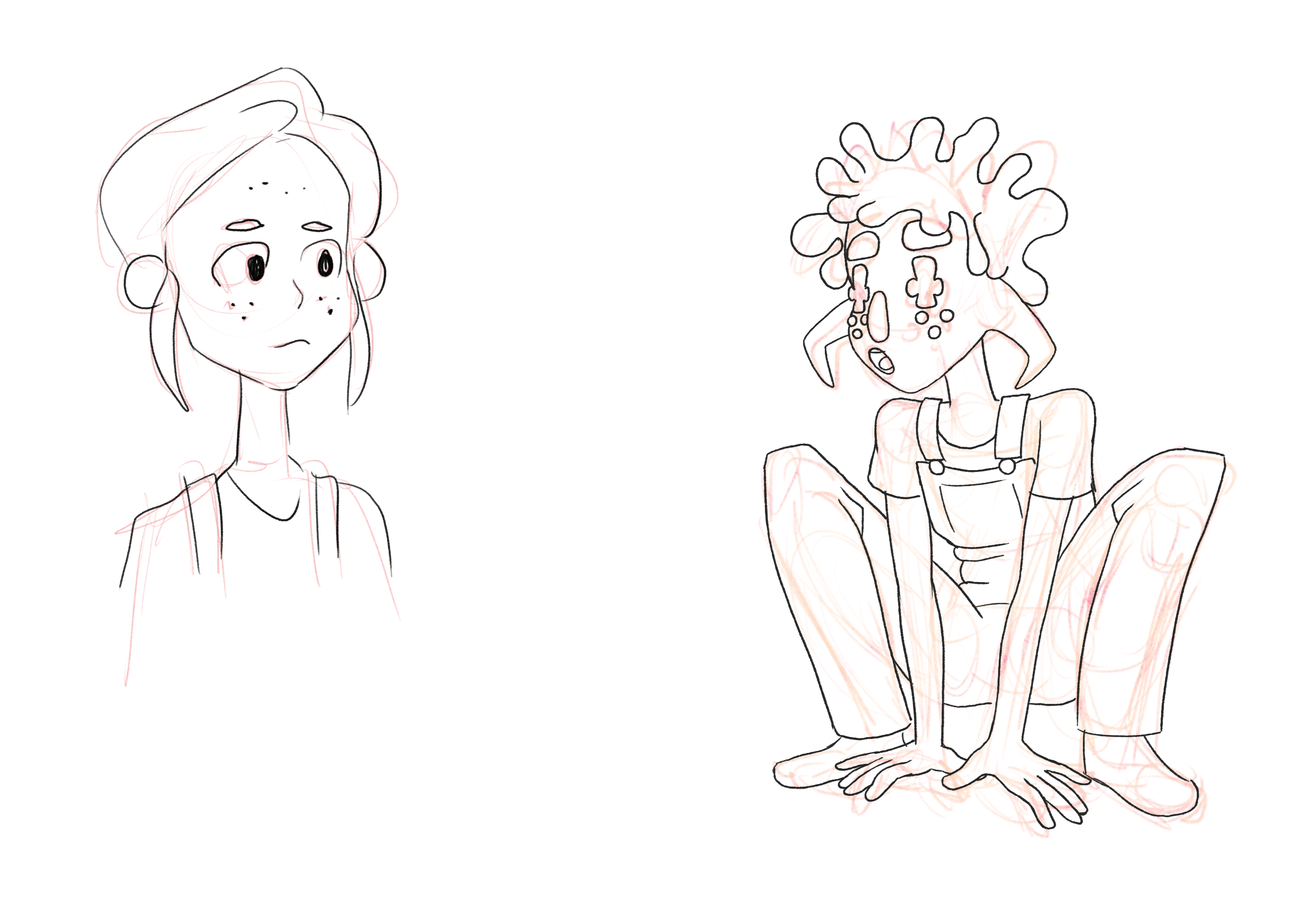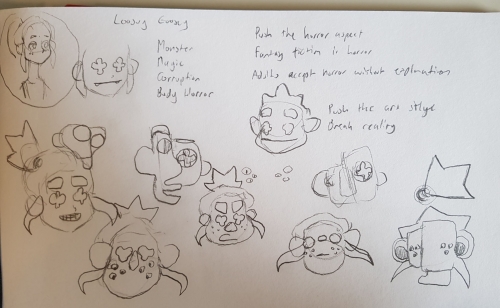
My response for week two of Animated Narratives
The concepts explored here are about Monsters, Magic, Corruption, Body Horror, Anxiety, and Emotional Conflicts. I am developing a setting that contains monsters that are influenced by the emotions of people around them and having the appearance of character’s morph to reflect their own struggle with handling their own emotional responses. The character’s body would morph and corrupt as they make toxic and selfish emotional decisions to show how their actions are changing the way that other people around them are viewing them.
Using animation, I would be able to distort a character by swapping out body parts with bizarre and unnerving shapes. Changing them from a recognisable and safe human appearance, into an unnerving and off-putting form. The medium would allow for changing the colour of the character’s line-art to a vibrant blue when parts of the body are altered, and to have bits of the body suddenly pop into another shape with a bit of a wiggle to emphasise how un-human it is. Pushing the concept further, the character’s body could even start to lose its uniformity and resemble a more surrealist style.
Having a character’s appearance change to show an internal struggle or the impact of an external force is prevalent within animated television programs. In ‘Kipo and the Age of Wonderbeasts’ (Kipo and the Age of Wonderbeasts, 2020) the main character Kipo suddenly experiences her body morphing and changing as she becomes a teenager. It is an unexpected change for the character that is caused by genetic alterations made on her in the past. During the show, these changes are something that Kipo learns to control and use throughout her adventure. In ‘She-Ra and the Princesses of Power’ (She-Ra and the Princesses of Power, 2018) a character’s appearance and mannerisms are changed to invoke a sense of unease and distress in the audience that reinforces the sudden change in relationship between the characters. The character Catra has been forced into a mind-control situation by the series’ antagonist. Her long hair is cut down short, she is changed into the same style of clothes as the antagonist, her eyes now glow green with no pupils, and her voice has changed from arrogant and cocky into a very calm and polite tone. During the scene where the series protagonist learns about this change the audience is sharing the feeling of looking at someone you know so well, but who has now changed so much you do not know who they are.
When developing a setting that uses fantasy elements such as monsters and magic, I feel pulled in two directions: To explain how things work and to leave everything vague and mysterious. When I am a part of the audience engaging with a story I enjoy when parts of the magic are left without explanation. The mystery can enhance the mystique, and also there is a lot to enjoy about being able to make my own theories to explain it. As a creator I find that I can easily fall down the hole of trying to make these own theories about my own work, and then they end up in the work, and suddenly there is no mystery. At the same time though I am conscious of the line between leaving some things unexplained and having a world that is confusing and difficult to engage with.
I recently had a discussion with an RMIT Lecturer about this story idea and the use of magic and monsters. They pointed out that whilst a lot of media targeted towards adults will be scrutinised for un-answered mysteries within the narrative, the genres of Horror and Thriller have a freedom to say that magic and monsters exist in a contemporary setting without explaining how.
This point was further solidified for me when I came across an interview of Stanley Kubrick by Vicente Molina Foix (ed. Castle 2008). During the interview Stanley is asked about making ’The Shining’ and he goes on to comment about the genre:
“About the only law that I think relates to the genre is that you should not try to explain, to find neat explanations for what happens, and that the object of the thing is to produce a sense of the uncanny. Freud in his essay on the uncanny wrote that the sense of the uncanny is the only emotion which is more powerfully expressed in art than in life… And I read an essay by the great master H.P. Lovecraft where he said that you should never attempt to explain what happens, as long as what happens stimulates people’s imagination, their sense of the uncanny, their sense of anxiety and fear. And as long as it doesn’t, within itself, have any obvious inner contradictions, it is just a matter of, as it were, building on the imagination…”
When I originally started developing this story idea about monsters, emotions, and having the two clash and change how someone appears I did not think of it as a Horror story. My mind was very set on mainstream animation, it was to be a contemporary fantasy adventure story. This new understanding for how I can leverage elements from the horror genre has opened a new door for my designs and concepts. Using a warped character design to invoke those horror feelings of unease in an audience is a perfect way to enhance how the relationships between characters are changing, and the horror elements can be used to maintain a mystery to the setting.
Kipo and the Age of Wonderbeasts. (2020). Netflix, 14 January.
She-Ra and the Princesses of Power. (2018). Netflix, 13 November.
Castle, A (ed.) 2008, The Stanley Kubrick Archives, Taschen, Germany.
About This Work
By Maxine Gorey
Email Maxine Gorey
Published On: 15/03/2021

